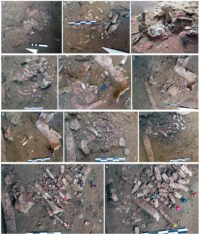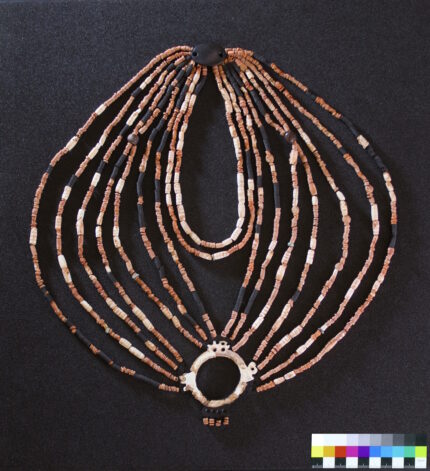An elaborate necklace of thousands of beads discovered in a child’s grave in the Neolithic village of Ba’ja, southern Jordan, has been reassembled bead by bead five years after it was unearthed. It is the most elaborate adornment ever found at a Neolithic site, and is a unique testament to the funerary practices of the elite in this prehistoric farming and livestock-raising community.
Located not far from the Nabatean rock-cut city of Petra, Ba’ja was occupied between around 7,400 and 6,800 B.C. It is densely packed with multi-layered stone dwellings that are believed to have been homes and stores for family units. While the deceased were usually buried elsewhere, some of the dead were buried in individual, double or collective graves underneath the structures.
In the summer of 2018, a stone-lined cist grave was found underneath the floor of a stone house. It contained the skeletal remains of a child about eight years old buried in fetal position. While the sex could not be conclusively determined, the shape of the chin suggests the child was female. The archaeological team named her Jamila (meaning “beautiful” in Arabic).

The bead concentrations were distributed between two large pendants: a mother-of-pearl ring carved from a large single pearl oyster shell with multiple perforations and a double-perforated oval hematite pendant. The mother-of-pearl is particularly spectacular, and cannot have been local. It was likely an import from the Red Sea more than 700 miles away.
Some of the beads were found still aligned in several rows on the left side (the child was positioned on her left side and gravity did the rest) but many were scattered. Repeated patterns and combinations of bead type and color in the surviving rows indicate the beads cannot have been scattered over the body, but it was not clear whether they were originally part of a necklace, a decorated garment, chest piece or something else entirely.
The grave was documented in painstaking detail, and the concentrations and surviving rows made it possible for researchers to reconstruction the original configuration. The entire assemblage was loaned to research laboratories in Germany and France for cleaning, consolidation, restoration and analysis.
Most of the beads found on the first excavated upper layers, those corresponding to the right side of the body were disturbed due to the displacements and damage of the skull and right side of the skeletal remains. To determine reliable scenarios of bead combinations, the archaeological documentation was carefully studied, focusing on preserved alignments of beads (as a “DNA” sequencing approach) to reconstruct eventual “chains”. Mathematical analyses were performed to estimate the lengths of these chains. Use-wear analyses allowed the identification of differential intensities of use while providing indications on the hanging system of the beads. The identifications were based on comparisons with key studies describing patterns of use due to bead-to-bead alignments within ornamental compositions…. Finally, it was essential to reconstruct the initial shape of the ring, which was very damaged by the burial conditions, as the missing parts may have played important role in the structure of the ornament, for example, the number and lengths of rows of beads.
The result of the reconstruction is nothing short of spectacular, 12 inches wide at the widest point and 12 inches long at its longest. The most plausible arrangement for all those beads and pendants turned out to be ten rows, seven connected to each side of the mother-of-pearl ring and 3 separated from it.
The reconstructed necklace (with black foam placeholders for the beads that are too fragile to be integrated) is now on display at the Museum of Petra.
* This article was originally published here







No comments:
Post a Comment